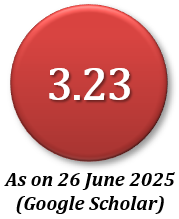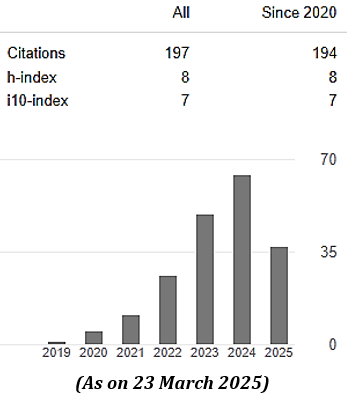Effect of Heat Input on the Wire-Arc Additive Manufactured Steel Structures
Abstract
Wire arc additive manufacturing (WAAM) is one of the less-explored metal 3D printing technologies that hold up a huge potential for large-scale product manufacturing across multiple industries. The low-cost AM uses arc energy as a heat source and metallic wire as a feedstock material. The process is sustainable and supports green manufacturing. However, the major challenge associated with the WAAM is that heat management leads to the development of residual stress causing dimensional inaccuracy and poor surface finish. Therefore, four-layer straight wall structures are fabricated by depositing material layer-upon-layer with nine distinct heat inputs (HI). The prime focus of the work is to study the effect of HI on the dimensional accuracy and the quality of deposited structures. The influence of deposition height on the surface topography is investigated. Furthermore, the effect of HI on the mechanical properties of the WAAM-printed thin wall is examined. The results show that with increase in the number of depositing layers, surface roughness values get increased under the similar process parameter used for the part fabrication. Therefore, it is recommended to re-adjust the process parameter after certain layers of deposition with proper monitoring of the thermal condition in the deposited layers while fabricating medium to large WAAM components. The outcomes from the studies show that increases in the HI while fabricating the WAAM component deteriorates the surface quality of the deposited layer and are responsible for reducing the mechanical properties of the WAAM-printed component.
Downloads
References
Dirisu, P., Supriyo, G., Martina, F., Xu, X. and Williams, S., (2020). Wire plus arc additive manufactured functional steel surfaces enhanced by rolling. International Journal of Fatigue, 130, p.105237.
DOI: https://doi.org/10.1016/j.ijfatigue.2019.105237
Filippov, A., Shamarin, N., Moskvichev, E., Savchenko, N., Kolubaev, E., Khoroshko, E. and Tarasov, S., (2021). Heat Input Effect on Microstructure and Mechanical Properties of Electron Beam Additive Manufactured (EBAM) Cu-7.5 wt.% Al Bronze. Materials, 14(22), p.6948.
DOI: https://doi.org/10.3390/ma14226948
Garcia-Cabezon, C., Castro-Sastre, M.A., Fernandez-Abia, A.I., Rodriguez-Mendez, M.L. and Martin-Pedrosa, F., (2022). Microstructure–hardness–corrosion performance of 17–4 precipitation hardening stainless steels processed by selective laser melting in comparison with commercial alloy. Metals and Materials International, 28(11), pp.2652-2667) DOI: https://doi.org/10.1007/s12540-021-01155-8
Gisario, A., Kazarian, M., Martina, F. and Mehrpouya, M., (2019). Metal additive manufacturing in the commercial aviation industry: A review. Journal of Manufacturing Systems, 53, pp.124-149.
DOI: https://doi.org/10.1016/j.jmsy.2019.08.005
Gudur, S., Nagallapati, V., Pawar, S., Muvvala, G. and Simhambhatla, S., (2021). A study on the effect of substrate heating and cooling on bead geometry in wire arc additive manufacturing and its correlation with cooling rate. Materials Today: Proceedings, 41, pp.431-436.
DOI: https://doi.org/10.1016/j.matpr.2020.10.071
Guo, Y., Quan, G., Celikin, M., Ren, L., Zhan, Y., Fan, L. and Pan, H., (2022). Effect of heat treatment on the microstructure and mechanical properties of AZ80M magnesium alloy fabricated by wire arc additive manufacturing. Journal of Magnesium and Alloys, 10(7), pp.1930-1940. DOI: https://doi.org/10.1016/j.jma.2021.04.006
Hönnige, J.R., Colegrove, P.A., Ahmad, B., Fitzpatrick, M.E., Ganguly, S., Lee, T.L. and Williams, S.W., (2018). Residual stress and texture control in Ti-6Al-4V wire+ arc additively manufactured intersections by stress relief and rolling. Materials & Design, 150, pp.193-205. DOI: https://doi.org/10.1016/j.matdes.2018.03.065
International Organization for Standardization, (1996). Geometrical Product Specifications (GPS)--surface Texture: Profile Method--rules and Procedures for the Assessment of Surface Texture. ISO.
Jafari, D., Vaneker, T.H. and Gibson, I., (2021). Wire and arc additive manufacturing: Opportunities and challenges to control the quality and accuracy of manufactured parts. Materials & Design, 202, p.109471. DOI: https://doi.org/10.1016/j.matdes.2021.109471
Kumar, V., Mandal, A., Das, A.K. and Kumar, S., (2021). Parametric study and characterization of wire arc additive manufactured steel structures. The International Journal of Advanced Manufacturing Technology, 115(5-6), pp.1723-1733. DOI: https://doi.org/10.1007/s00170-021-07261-6
Lervåg, M., Sørensen, C., Robertstad, A., Brønstad, B.M., Nyhus, B., Eriksson, M., Aune, R., Ren, X., Akselsen, O. M., and Bunaziv, I., (2020). Additive manufacturing with superduplex stainless steel wire by cmt process. Metals, 10(2), p.272.
DOI: https://doi.org/10.3390/met10020272
Nagamatsu, H., Sasahara, H., Mitsutake, Y. and Hamamoto, T., (2020). Development of a cooperative system for wire and arc additive manufacturing and machining. Additive Manufacturing, 31, p.100896. DOI: https://doi.org/10.1016/j.addma.2019.100896
Ohsawa, K., Hayashi, Y., Hasunuma, R. and Yamabe, K., (2009), November. Roughness increase on surface and interface of SiO2 grown on atomically flat Si (111) terrace. In Journal of Physics: Conference Series (Vol. 191, No. 1, p. 012031). IOP Publishing. DOI: 10.1088/1742-6596/191/1/012031
Pépe, N., Egerland, S., Colegrove, P.A., Yapp, D., Leonhartsberger, A. and Scotti, A., (2011). Measuring the process efficiency of controlled gas metal arc welding processes. Science and Technology of Welding and Joining, 16(5), pp.412-417. DOI: https://doi.org/10.1179/1362171810Y.0000000029
Qiu, Z., Dong, B., Wu, B., Wang, Z., Carpenter, K., Wu, T., Zhang, J., Wexler, D., Zhu, H. and Li, H., (2021). Tailoring the surface finish, dendritic microstructure and mechanical properties of wire arc additively manufactured Hastelloy C276 alloy by magnetic arc oscillation. Additive Manufacturing, 48, p.102397. DOI: https://doi.org/10.1016/j.addma.2021.102397
Qi, Z., Cong, B., Qi, B., Zhao, G. and Ding, J., (2018). Properties of wire+ arc additively manufactured 2024 aluminum alloy with different solution treatment temperature. Materials Letters, 230, pp.275-278. DOI: https://doi.org/10.1016/j.matlet.2018.07.144
Rosli, N.A., Alkahari, M.R., bin Abdollah, M.F., Maidin, S., Ramli, F.R. and Herawan, S.G., (2021). Review on effect of heat input for wire arc additive manufacturing process. Journal of Materials Research and Technology, 11, pp.2127-2145. DOI: https://doi.org/10.1016/j.jmrt.2021.02.002
Sedlaček, M., Podgornik, B. and Vižintin, J., (2009). Influence of surface preparation on roughness parameters, friction and wear. Wear, 266(3-4), pp.482-487. DOI: https://doi.org/10.1016/j.wear.2008.04.017
Sydow, B., Jhanji, A., Hälsig, A., Buhl, J. and Härtel, S., (2022). The Benefit of the Process Combination of Wire Arc Additive Manufacturing (WAAM) and Forming—A Numerical and Experimental Study. Metals, 12(6), p.988. DOI: https://doi.org/10.3390/met12060988
Wang, S., Gu, H., Wang, W., Li, C., Ren, L., Wang, Z., Zhai, Y. and Ma, P., (2020). The influence of heat input on the microstructure and properties of wire-arc-additive-manufactured Al-Cu-Sn alloy deposits. Metals, 10(1), p.79. DOI: https://doi.org/10.3390/met10010079
Wu, Q., Lu, J., Liu, C., Fan, H., Shi, X., Fu, J. and Ma, S., (2017). Effect of molten pool size on microstructure and tensile properties of wire arc additive manufacturing of Ti-6Al-4V alloy. Materials, 10(7), p.749. DOI: https://doi.org/10.3390/ma10070749
Xie, Miao-Xia, et al., (2019). "Effect of heat input on porosity defects in a fiber laser welded socket-joint made of powder metallurgy molybdenum alloy." Materials 12.9: 1433. DOI: https://doi.org/10.3390/ma12091433
Xie, M.X., Li, Y.X., Shang, X.T., Wang, X.W. and Pei, J.Y., (2019). Effect of heat input on porosity defects in a fiber laser welded socket-joint made of powder metallurgy molybdenum alloy. Materials, 12(9), p.1433. DOI: https://doi.org/10.1016/j.jmatprotec.2017.09.020
Yadollahi, A., Shamsaei, N., Thompson, S.M., Elwany, A. and Bian, L., (2017). Effects of building orientation and heat treatment on fatigue behavior of selective laser melted 17-4 PH stainless steel. International Journal of Fatigue, 94, pp.218-235. DOI: https://doi.org/10.1016/j.ijfatigue.2016.03.014
Zeng, J., Nie, W. and Li, X., (2021). The influence of heat input on the surface quality of wire and arc additive manufacturing. Applied Sciences, 11(21), p.10201. DOI: https://doi.org/10.3390/app112110201
Zeng, Y., Wang, X., Qin, X., Hua, L. and Xu, M., (2021). Laser Ultrasonic inspection of a Wire+ Arc Additive Manufactured (WAAM) sample with artificial defects. Ultrasonics, 110, p.106273. DOI: https://doi.org/10.1016/j.ultras.2020.106273
Zhang, C., Qiu, Z., Zhu, H., Wang, Z., Muránsky, O., Ionescu, M., Pan, Z., Xi, J. and Li, H., (2022). On the effect of heat input and interpass temperature on the performance of inconel 625 alloy deposited using wire arc additive manufacturing–cold metal transfer process. Metals, 12(1), p.46. DOI: https://doi.org/10.3390/met12010046
Zhou, Y., Lin, X., Kang, N., Huang, W., Wang, J. and Wang, Z., (2020). Influence of travel speed on microstructure and mechanical properties of wire+ arc additively manufactured 2219 aluminum alloy. Journal of Materials Science & Technology, 37, pp.143-153. DOI: https://doi.org/10.1016/j.jmst.2019.06.016
MIJST follows the open access policy.

This work is licensed under a Creative Commons Attribution-NonCommercial 4.0 International License. This allows anyone to copy, share, distribute, and modify the work for non-commercial purposes, where the original work and source should be properly credited.
















